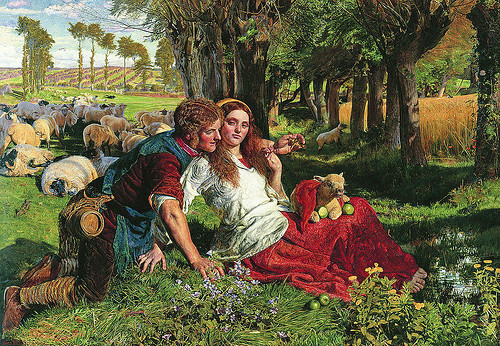In May 1851 he [Holman Hunt] wrote to the poet Coventry Patmore, who had been responsible for enlisting Ruskin's support, asking to borrow a copy of the works of the seventeenth-century theologian Richard Hooker. He added: 'As however I am obliged to read for my next year's subjects much just now, I hope you will be able to spare it some time'. Hooker provided the theme of The Hireling Shepherd, with its underlying attack on sectarianism for deflecting the clergy from the task of tending their flock. The picture marks out a new direction, in which the symbolism is so arcane as to be virtually impenetrable without a literary gloss. The painting can, however, be enjoyed on many levels. Its sunlit landscape, with its closely observed blue shadows, was painted at Ewell, Surrey, between June and December 1851 and was Hunt's most ambitious attempt at naturalism to date.
His dislike of narrow sectarianism-which underlies the composition of The Hireling Shepherd and Our English Coasts, 1852-deepened into disgust on his first visit to Jerusalem, where he found squabbling Christian sects vying with each other to convert the poverty-stricken Jews. Bribery was endemic and Hunt was so incensed by the activities of Samuel Gobat, Anglican bishop of Jerusalem, in this respect that in 1858 he published a pamphlet unmasking him (ODNB).

This comment has been removed by a blog administrator.
ReplyDelete